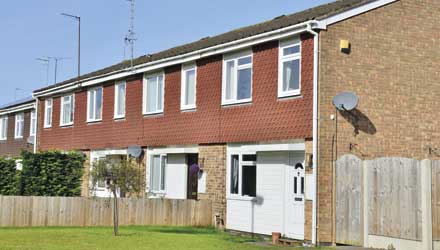By Sophie Neaves on Mon 19 February 2024 in Blog
A Guide to the Decent Homes Standard
This guide will cover current information about the Decent Homes Standard for social housing and the plans to extend to the private rental sector. Some of these minimum standards highlight the importance of ventilation in social housing to protect tenants’ health by dealing with hazards such as damp and mould.
Here’s everything you need to know as a landlord or housing developer about the Decent Homes Standard.

What is the Decent Homes Standard?
The Decent Homes Standard is the minimum standard for social housing in England and Northern Ireland. This is proposed to extend to the private rental sector following an ongoing government consultation.
The Decent Homes Standard came about in the year 2000 to improve and regulate the quality of social housing. The government wanted to raise the standards and protect residents from hazardous living conditions.
A decent home is defined as being “free from serious health and safety hazards, such as fall risks, fire risks, or carbon monoxide poisoning”, and those houses that do not meet the criteria within the standards are known as ‘non-decent homes.’
There are a few factors that are considered when reviewing a property to meet Decent Homes Standards. These cover a range of key elements such as the building’s structural integrity, whether it is in a reasonable state of repair, the age and layout of facilities, noise insulation, efficient heating, damp and mould, and thermal comfort.
For social housing, providers are expected to ensure that their properties meet these standards. They work alongside the Housing Health and Safety Rating System (HHSRS) and create a legally binding framework that is overseen and enforced by regulatory bodies, housing associations and local authorities.
Decent Homes Standard consultation
In 2020, the government committed to review the Decent Homes Standard in the social housing white paper. Then, in 2022, the Levelling Up White Paper went on to commit to halving the number of non-decent rented homes (across both social and private sectors) by 2030. In 2022, the government consulted to apply the Decent Homes Standard to cover the private rented sector.
In June 2023, the government relaunched its review to consider various changes, such as:
-
Whether the current Decent Homes Standards sets the correct standard in relation to mould and damp to keep occupants safe.
-
Introduction of a Minimum Energy Efficiency Standard for the social rented sector.
-
Updates to the list of items that should be kept in a reasonable state of repair to be considered ‘decent’.
-
Updates to the list of services and facilities to reflect modern expectations.
-
Updates to how the condition of building components (roofs, walls, windows) are measured.
At the time of writing, there is no set date when the Decent Homes Standard will be introduced to the private rented sector. It will be following further consultation.
What is the Decent Homes Standard checklist?
Whilst there isn’t a defined Decent Homes Standard checklist, there are several key areas that will be looked at and assessed based on various criteria. These include:
-
Must meet the current statutory minimum standard for housing: the property must be fit for human habitation (as per the Human Habitation Act 2018) and be free of hazards that could pose a risk to the health and safety of those living at the property. These factors are assessed through the Housing Health and Safety Rating System (HHRS).
-
Freedom from damp and mould: the property shouldn’t have any dampness or condensation that could adversely affect the health of the occupants.
-
Ventilation and natural light: there should be adequate provision for good ventilation and natural light within the living space.
Be in a reasonable state of repair: the property must be structurally stable and free from major disrepair. Areas such as the roof, windows and doors, and the heating system should be in a reasonable condition. -
Have reasonably modern facilities and services: the facilities should be reasonably modern. The decent home's standard kitchen (20 years old or less) and bathroom (30 years old or less) should have adequate space and layout and be appropriately located with adequate insulation against external noise.
-
Provide a reasonable degree of thermal comfort: from effective insulation and efficient heating, with inspection of the type of heating system in place.
What is the Housing Health and Safety Rating System (HHSRS)?
The Housing Health and Safety Rating System (HHRS) was introduced as part of the Housing Act 2004 and is key for the assessment of social housing conditions. It’s a risk-based evaluation system to discover if a property has any potential hazards.
-
Category 1 hazards pose an imminent health risk.
-
Category 2 hazards are serious but unlikely to cause immediate direct harm.
It looks at 29 different housing hazards. It assesses things like falls, fire safety, electrical safety, any dampness, heating and sanitation issues, alongside security risks to occupants. Used by local authorities, it determines if the property is up to standards or if enforcement action is required to address the issues and make sure occupants are safe.
There are plans in place for the government to make modifications to the HHSR. A thorough external assessment was commissioned by the government and concluded in 2022 which will serve as the basis for the changes. Upcoming revisions include the amalgamation of certain assessed hazards and the implementation of a more straightforward system for categorising assessment results.
The government aims to publish baseline criteria indicating whether a property harbours significant hazards. Plus, new statutory operating and enforcement guidelines, along with a collection of case studies will be publicly available.
How will it be enforced?
Local authority housing officers or environmental health officers currently inspect social properties to see if they meet the Decent Homes Standards. These inspections may be proactive or where an occupant raises a concern. Hazard awareness notices and improvement notices can be issued, or emergency remedial action, civil penalties or legal action in some cases.
Currently, it’s down to local councils to identify hazards in privately rented properties and take action against landlords, however, the consultation to extend the Decent Homes Standard to the private sector proposes a more enforceable standard. It proposes that any breach would be considered a criminal offence, as well as a “banning order offence” - with certain exemptions, such as listed properties. The aim is to “crackdown on non-compliant landlords while protecting the reputation of responsible ones.”
The consultation outlined private landlords would need to register their property on the Property Portal once live. It proposes landlords “use the Portal to self-declare whether the property is decent” to declare exemptions. Any false or misleading information could mean a penalty of up to £30,000.
How Airflow can help
If the Decent Homes Standard is introduced to the private rented sector, it’s estimated that nearly 1 million private landlords may need to upgrade their properties. The consultation says that there is a possibility for a “cost cap” on the improvements to be made by a private landlord, with a set upper limit. Time will also be allocated to meet the standards once it is rolled out, but education about the latest developments and a proactive approach is key.
Airflow can help you ensure your property has a proper ventilation system in place to avoid damp and mould issues and keep air quality to a high standard. Effective ventilation also has the benefit of making a property more energy efficient.
We specialise in ventilation solutions and provide social and private housing development with mechanical ventilation systems, helping landlords meet legal requirements and tenants’ needs.
So whether you’re preparing to adhere to the Decent Homes Standard in the private sector or looking to improve social housing ventilation in your properties, considering options such as Mechanical Ventilation with Heat Recovery System (MVHR), we can help.
Read more about the importance and benefits of ventilation in social housing and our range of solutions that address reactive and proactive maintenance alongside new-build developments. Contact us for more information, and rest easy you can comply with the Decent Homes Standard.


